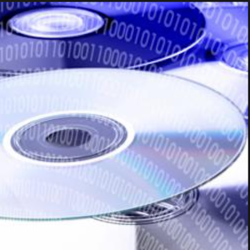Spinning CD
 The music on a CD is encoded on tiny raised ridges lying on a spiraling path (up to
long) that winds outward from the center of the disc. A laserbeam tracks along the path at a constant linear speed of
and the fluctuating light reflected off the ridges carries the information lifted from the CD. Typically, the track begins
from the center and ends about
from the center. To keep the linear speed of the laser readout unit constant, the angular speed at which the disc turns is continuously varied. Find the approximate difference (in rad/s) between the angular speed of the disc at the beginning and at the end of the data path.
The music on a CD is encoded on tiny raised ridges lying on a spiraling path (up to
long) that winds outward from the center of the disc. A laserbeam tracks along the path at a constant linear speed of
and the fluctuating light reflected off the ridges carries the information lifted from the CD. Typically, the track begins
from the center and ends about
from the center. To keep the linear speed of the laser readout unit constant, the angular speed at which the disc turns is continuously varied. Find the approximate difference (in rad/s) between the angular speed of the disc at the beginning and at the end of the data path.
This section requires Javascript.
You are seeing this because something didn't load right. We suggest you, (a) try
refreshing the page, (b) enabling javascript if it is disabled on your browser and,
finally, (c)
loading the
non-javascript version of this page
. We're sorry about the hassle.
0 solutions
No explanations have been posted yet. Check back later!